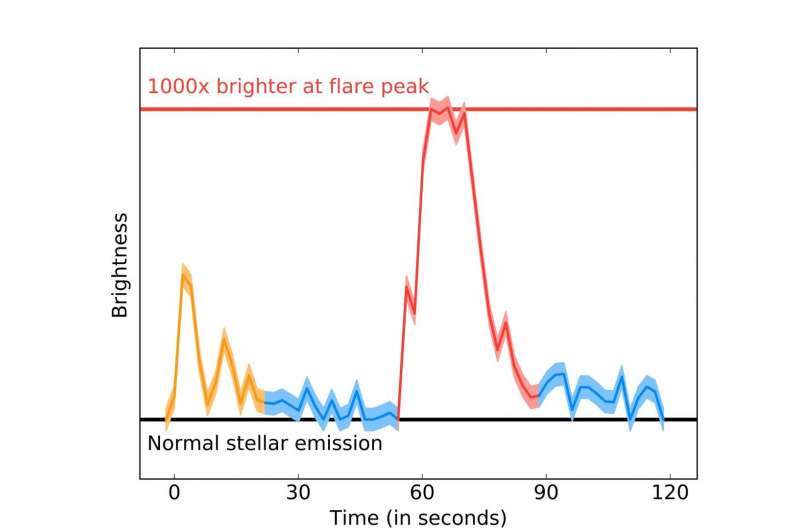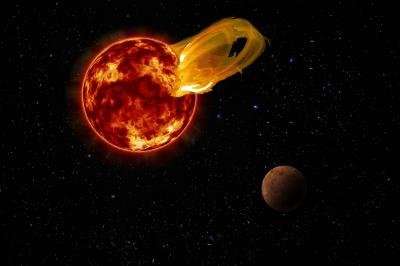Proxima Centauri's no good, very bad day

A team of astronomers led by Carnegie's Meredith MacGregor and Alycia Weinberger detected a massive stellar flare—an energetic explosion of radiation—from the closest star to our own Sun, Proxima Centauri, which occurred last March. This finding, published in Astrophysical Journal Letters, raises questions about the habitability of our Solar System's nearest exoplanetary neighbor, Proxima b, which orbits Proxima Centauri.
MacGregor, Weinberger and their colleagues—the Harvard-Smithsonian Center for Astrophysics' David Wilner and Adam Kowalski and Steven Cranmer of the University of Colorado Boulder—discovered the enormous flare when they reanalyzed observations taken last year by Atacama Large Millimeter/submillimeter Array, or ALMA, a radio telescope made up of 66 antennae.
At peak luminosity it was 10 times brighter than our Sun's largest flares when observed at similar wavelengths. Stellar flares have not been well studied at the wavelengths detected by ALMA, especially around stars of Proxima Centauri's type, called M dwarfs, which are the most common in our galaxy.
"March 24, 2017 was no ordinary day for Proxima Cen," said lead author MacGregor.
The flare increased Proxima Centauri's brightness by 1,000 times over 10 seconds. This was preceded by a smaller flare; taken together, the whole event lasted fewer than two minutes of the 10 hours that ALMA observed the star between January and March of last year.
Stellar flares happen when a shift in the star's magnetic field accelerates electrons to speeds approaching that of light. The accelerated electrons interact with the highly charged plasma that makes up most of the star, causing an eruption that produces emission across the entire electromagnetic spectrum.

"It's likely that Proxima b was blasted by high energy radiation during this flare," MacGregor explained, adding that it was already known that Proxima Centauri experienced regular, although smaller, x-ray flares. "Over the billions of years since Proxima b formed, flares like this one could have evaporated any atmosphere or ocean and sterilized the surface, suggesting that habitability may involve more than just being the right distance from the host star to have liquid water."
A November paper that also used these ALMA data interpreted its average brightness, which included the light output of both the star and the flare together, as being caused by multiple disks of dust encircling Proxima Centauri, not unlike our own Solar System's asteroid and Kuiper belts. The authors of that study said that the presence of dust pointed to the existence of more planets or planetary bodies in the stellar system.
But when MacGregor, Weinberger, and their team looked at the ALMA data as a function of observing time, instead of averaging it all together, they were able to see the transient explosion of radiation emitted from Proxima Centauri for what it truly was.
"There is now no reason to think that there is a substantial amount of dust around Proxima Cen," Weinberger said. "Nor is there any information yet that indicates the star has a rich planetary system like ours."
More information: Meredith A. MacGregor et al. Detection of a Millimeter Flare from Proxima Centauri, The Astrophysical Journal (2018). DOI: 10.3847/2041-8213/aaad6b
Journal information: Astrophysical Journal Letters , Astrophysical Journal
Provided by Carnegie Institution for Science




















